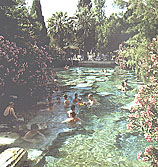|
Pamukkale (Hierapolis) is both, a magical and spectacular natural site, unique in the world
and with its ancient ruins it is perhaps the most attractive spot for tourists.
Hierapolis was named after Hiera, the wife of Telephos, founder of Pergamum in mythology.
As you approach the site of Pamukkale / Hierapolis from Denizli, (only 20 km)
a long white smudge along the hills to Hierapolis from Denizli, (only 20 km)
a long white smudge along the hills to
|

|
|
|
 Pamukkale - hot springs and
spetacular scenery Pamukkale - hot springs and
spetacular scenery
|
the north suggests a landslide or open cast mine. Getting closer, this resolves into the edge
of a plateau, more than 100m higher than the level of the river valley and absolutely smothered in white travertine
terraces.
Pamukkale is one of the most extraordinary natural wonders in Turkey. Dozens of coaches daily make the long excursion,
(three hours drive from Bodrum), Marmaris or Kusadasi. Stay over-night if you can to enjoy its tranquillity early
in the morning or in the evening.
The big attraction is a vast white cliff side with scallop-shaped basins of water and frozen
waterfalls. It looks as if it's made out of snow or cloud or balls of cotton. The Turks have dubbed this geological
fairyland Pamukkale (cottoncastle), from pamuk for cotton and kale for castle.
Pamukkale Thermal Pool
For thousands of years a deep underground spring has been pouring out streams of hot, mineral-saturated water.
As it has flowed down the mountainside the steaming water has hollowed enormous circular basins in the earth, and
the water's rich mineral content has coated them in a smooth layer of dazzlingly-white calcareous rock. To the
ancients such beauty could only mean that the place was sacred to the gods. Built near the natural hot springs,
the grand city of Hierapolis attracted a steady stream of pilgrims, who came to bathe in the curative waters. Pamukkale
is located 250 km from Izmir and 20 km from Denizli. Most of the hotels are in Karahayit, 5 Ian north of Pamukkale.
The water is 42-56 C, the pH is 5.98, similar to Pamukkale, but the water has more iron content.
Capacity
The Pamukkale hot springs flow at a rate of 400 liters per second. The various facilities can accommodate about
6,000 people a day which amounts to 600 liters of water per person per day.
Pamukkale Travertines
Physio-chemical Characteristics and indications
The mineral-rich Pamukkale hot spring waters are high in calcium, magnesium sulfate and bicarbonate. They also
contain carbon dioxide and have a radioactive content of 1,537 picokuri/liter (or 56 bekerel/liter). Water temperature
is 36 to 38 C with a pH of 6. Total mineral content is 2,430 mg/It. The waters are used for drinking and bathing.
They are recommended for the treatment of rheumatic, dermatological and gynecological diseases, neurological and
physical exhaustion, digestive maladies and nutritional disorders.
Treatments and accommodations
Throughout history, Pamukkale has been a famous spa, with baths and open pools set into the snow-white cliffs.
Bath treatments take place in natural pools, which developed around the main hot springs. Hot mineral water spas
have been opened at a number of new and very comfortable hotels in the area.

|

|
|

|
|

|
|

|
|

Pamukkale-Hierapolis - a swim over ancient columns and ruins is a unique experience

|
|

|
|

|

This page in German


|

|
|
all boats - all itineraries,
choose a gulet  from here
from here

|
|